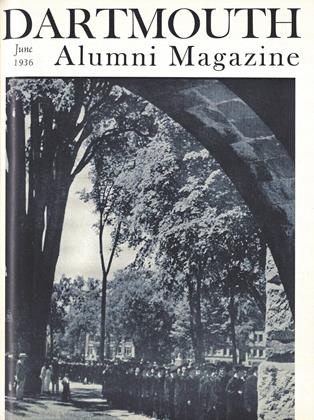Nearly fifty members of the New England Ophthalmological Society were in Hanover on Saturday, May 23, as guests of the Dartmouth Medical School. The work of the Department of Research in Physiological Optics was presented and discussed at the afternoon meeting of the Society, and an informal dinner was held at the Outing Club House in the evening. The afternoon session was presided over by Professor Adelbert Ames Jr., and included talks on various phases of the Department's work by Dr. Alfred Bielschowsky, Dr. E. H. Carleton, Professor Kenneth N. Ogle, and Dr. Werner Herzau. The Research Laboratory and the Eye Clinic of the Department of Research in Physiological Optics were open for inspection during the afternoon, and on the following morning a demonstration was given of clinical and research instruments and of the effects of aniseikonia on visual interpretation.
Professor Ames and Dr. Bielschowsky journeyed to Kansas City two weeks earlier to attend the meetings of the Association for Research in Ophthalmology and the Ophthalmological Section of the American Medical Association. They were on the program for a discussion of a paper on "The True Importance of Aniseikonia," and Dr. Bielschowsky also discussed a paper on "The Cortical Innervations of Ocular Movements."
Further explanation of the work in physiological optics at Dartmouth was made by Henry A. Imus, research fellow, who addressed a meeting of secondary school teachers at Albany, N. Y., April 30, on the subject, "Reading Difficulties in Cases of Aniseikonia." In contributing to the general subject of modern remedial methods for reading deficiencies, Mr. Imus explained aniseikonia, the eye defect discovered by the Department of Research in Physiological Optics of the Dartmouth Medical School, its symptoms, and its correction by means of iseikonic lenses.
 View Full Issue
View Full Issue
More From This Issue
-
 Article
ArticleSOCIAL SURVEY REPORT
June 1936 By The Editors -
 Class Notes
Class NotesClass of 1935
June 1936 By William W. Fitzhugh Jr. -
 Class Notes
Class NotesClass of 1929
June 1936 By F. William Andres -
 Class Notes
Class NotesClass of 1911
June 1936 By Prof. Nathaniel G. Burleigh -
 Article
ArticleTHE SONS AND DAUGHTERS OF '79
June 1936 By Clifford Hayes Smith -
 Class Notes
Class NotesClass of 1934
June 1936 By Martin J. Dwyer Jr.







